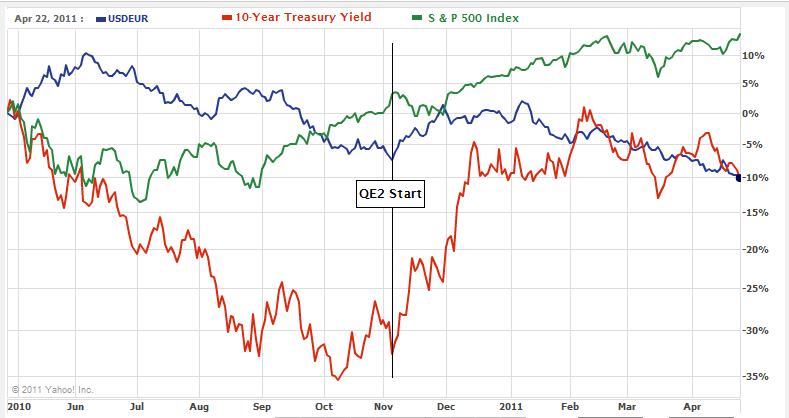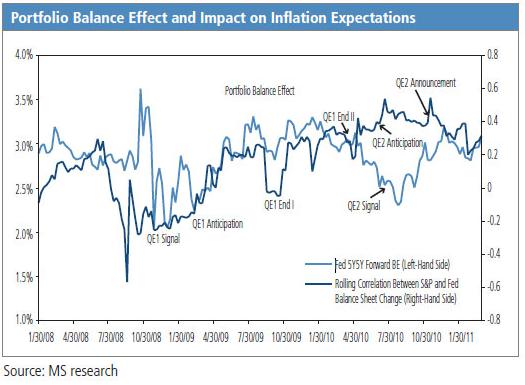Forex Blog |
| Dollar will Rally when QE2 Ends Posted: 27 Apr 2011 01:33 PM PDT In shifting their focus to interest rates, forex traders have perhaps overlooked one very important monetary policy event: the conclusion of the Fed’s quantitative easing program. By the end of June, the Fed will have added $600 Billion (mostly in US Treasury Securities) to its reserves, and must decide how next to proceed. Naturally, everyone seems to have a different opinion, regarding both the Fed’s next move and the accompanying impact on financial markets. The second installment of quantitative easing (QE2) was initially greeted with skepticism by everyone except for equities investors (who correctly anticipated the continuation of the stock market rally). In November, I reported that QE2 was unfairly labeled a lose-lose by the forex markets: “If QE2 is successful, then hawks will start moaning about inflation and use it as an excuse to sell the Dollar. If QE2 fails, well, then the US economy could become mired in an interminable recession, and bears will sell the Dollar in favor of emerging market currencies.” The jury is still out on whether QE2 was a success. On the one hand, US GDP growth continues to gather force, and should come in around 3% for the year. A handful of leading indicators are also ticking up, while unemployment may have peaked. On the other hand, actual and forecast inflation are rising (though it’s not clear how much of that is due to QE2 and how much is due to other factors). Stock and commodities prices have risen, while bond prices have fallen. Other countries have been quick to lambaste QE2 (including most recently, Vladimir Putin) for its perceived role in inflating asset bubbles around the world and fomenting the currency wars. Personally, I think that the Fed deserves some credit- or at least doesn’t deserve so much blame. If you believe that asset price inflation is being driven by the Fed, it doesn’t really make sense to blame it for consumer and producer price inflation. If you believe that price inflation is the Fed’s fault, however, then you must similarly acknowledge its impact on economic growth. In other words, if you accept the notion that QE2 funds have trickled down into the economy (rather than being used entirely for financial speculation), it’s only fair to give the Fed credit for the positive implications of this and not just the negative ones. But I digress. The more important questions are: what will the Fed do next, and how will the markets respond. The consensus seems to be that QE2 will not be followed by QE3, but that the Fed will not yet take steps to unwind QE2. Ben Bernanke echoed this sentiment during today’s inaugural press conference: “The next step is to stop reinvesting the maturing securities, a move that ‘does constitute a policy tightening.’ ” This is ultimately a much bigger step, and one that Chairman Bernanke will not yet commit. As for how the markets will react, opinions really start to diverge. Bill Gross, who manages the world’s biggest bond fund, has been an outspoken critic of QE2 and believes that the Treasury market will collapse when the Fed ends its involvement. His firm, PIMCO, has released a widely-read report that accuses the Fed of distracting investors with “donuts” and compares its monetary policy to a giant Ponzi scheme. However, the report is filled with red herring charts and doesn’t ultimately make any attempt to account for the fact that Treasury rates have fallen dramatically (the opposite of what would otherwise be expected) since the Fed first unveiled QE2. The report also concedes that, “The cost associated with the end of QEII therefore appears to be mostly factored into forward rates.” This is exactly what Bernanke told reporters today: “It’s [the end of QE2] ‘unlikely’ to have significant effects on financial markets or the economy…because you and the markets already know about it.” In other words, financial armmagedon is less likely when the markets have advanced knowledge and the ability to adjust. If anything, some investors who were initially crowded-out of the bond markets might be tempted to return, cushioning the Fed’s exit. If bond prices do fall and interest rates rise, that might not be so bad for the US dollar. It might lure back overseas investors, grateful both for higher yields and the end of QE2. Despite the howls, foreign central banks never shunned the dollar. In addition, the end of QE2 only makes a short-term interest rate that much closer. In short, it’s no surprise that the dollar is projected to “appreciate to $1.35 per euro by the end of the year, according to the median estimate of 47 analysts in a Bloomberg News survey. It will gain to 88 per yen, a separate poll shows.”  |
| You are subscribed to email updates from Forex Blog To stop receiving these emails, you may unsubscribe now. | Email delivery powered by Google |
| Google Inc., 20 West Kinzie, Chicago IL USA 60610 | |










0 comments:
Post a Comment